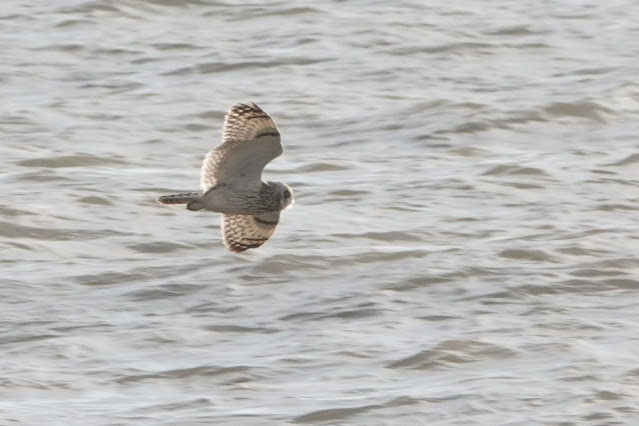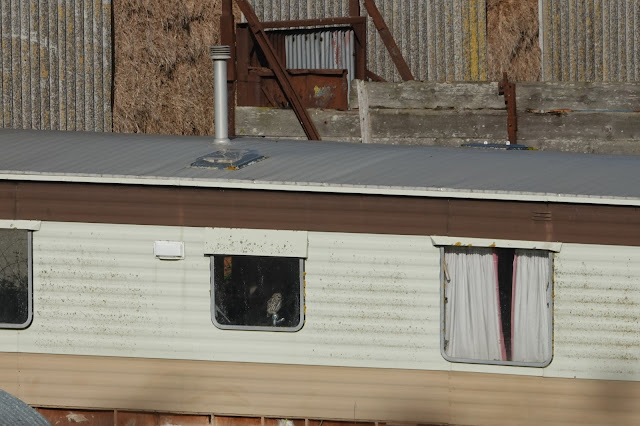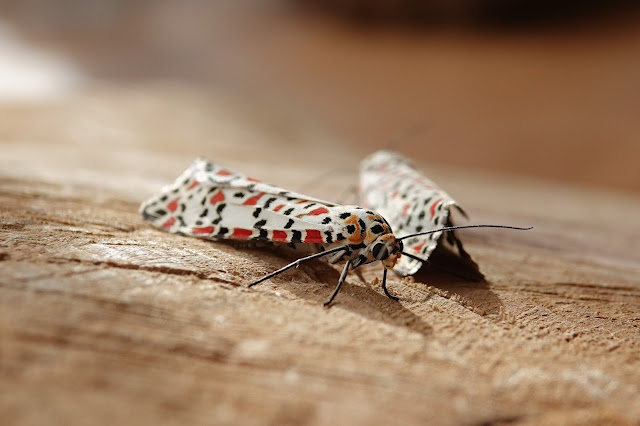21st October:
It was a pleasant enough drive up on the Friday with light
traffic and with time in hand I diverted to Landguard Point in the hope that
perhaps I could find a Pallas’s Warbler or some such sprite. Driving slowly down toward the Fort revealed many
ticking Robins and the odd calling Goldcrest and I was hopeful but despite a
slow, diligent walk around the common I found nothing out of the ordinary.
There must have been over 40 Robins in total but I did not
find another Goldcrest and just a single Chiffchaff and Blackcap for my troubles.
 |
| Robin |
Seventeen Redwings fed on the Common with a few Blackbirds
and cold grey brown Song Thrushes while it felt like the vocal Dunnocks hopping
around may have been migrants too.
 |
| Blackbirds |
 |
| Redwing |
 |
| Redwing |
 |
| Redwing |
 |
| Redwings |
The local House Sparrows were roving around in packs and
feasting on the last of the tiny blackberries and were joined by Linnets and Goldfinches. A few Meadow Pipits and Skylarks dribbled
south and four Fieldfare did likewise and seven Brents passed offshore.
I may have accidentally found some leaf mines…
 |
| Lyonetia clerkella on Cherry |
 |
| Stigmella aurella and Coptotriche marginea ? on Bramble |
 |
| Stigmella speciosa on Sycamore |
On again as the first few spots of rain arrived and up to
the Wrens at Lowestoft (passing two Red Kites on the way) where garden
skywatching once again failed to produce something new for Antony’s list
whereas I seem to always find something from almost any other friends
garden! Grey Wagtail was only the second
record and I had Chiffchaff, Greenfinch and a lone Meadow Pipit and one of the rooftop
Jackdaws had a partial pale collar suggesting that it may not have been that
local in origin.
After dark a check around the moth traps produced a Green Brindled
Crescent, Diamond Back, Rush Veneer and a Mallow as well as several Steatoda
nobilis, Araneus diadematus and Zygiella x-notata lurking around the
fences. Not a Redwing could be heard…
 |
| Mallow |
 |
| Green Brindled Crescent |
 |
| Zygiella x-notata |
 |
| Steatoda nobilis |
 |
| Not sure on this Harvestman yet |
22nd October:
We met the crew at Kessingland for a shot in the dark walk
south along the beach to see if any migrants were still on the move and were
greeted almost immediately with a flock of about 20 Greenfinches feeding on the
shingle plants. A glance left and it was suddenly clear that there were far
more and with small groups dropping in it quickly built up to about 200 birds. None of us could remember the last time we
saw over 20 Greenies let alone 200. It
was a magnificent and heart warming sight as they swirled round in a mass of
olive, green and gold.
 |
| Greenfinches |
A careful look through only produced an errant Linnet but there
were flocks of Skylarks and Meadow Pipits closer to the sea and the former were
singing quite strongly in the surprisingly warm early morning air. A single Swallow
was quickly followed by a House Martin and then three more Swallows powered
south along with small parties of Linnets, more Greenfinches, Goldfinches, five
Siskin and the odd Chaffinch.
A floppy Owl appeared way off in front near the dunes and
over the next half hour we had some superb views of this Short-eared as it
attempted to find respite from the Carrion Crows and constant disturbance from
the numerous dog walkers all of whom seemed completely oblivious to the
wondrous Owl floating around in front of them.
 |
| Short-eared Owl |
 |
| Short-eared Owl - Antony Wren |
The sea was very quiet (it always is when I go to Suffolk)
and there were none of the hoped for Little Gulls but we did pick up a few
Brents and Gannets. The ‘tew ticky tick tew’ of a Lapland Bunting caught my ear
but I could not find it as it headed over so we moved on towards the sluice
where two Rock Pipits came in off and Dunnocks were doing those curious lazy
circular flights above the bushes calling all the time.
 |
| Meadow Pipit |
A Dartford Warbler briefly churred in the Bracken but the
two Stonechats that I found were keeping low out of the wind. A large flock of
Lapwing and Starlings came up over the inland fields where 60 Goldfinches and a
couple of Reed Buntings fed and Buzzards circled over the distant woods. A Pink-footed Goose flew north and simply
vanished as soon as I called it out – it was most perplexing.
The big Sallow clump held two Chiffchaff and Goldcrest and a
host of lazy Wasps and a few Calliphora and Hoverflies. Common Darter, Small Copper and Peacock hinted
at summer days.
 |
| Small Copper |
 |
| Dock Bug |
 |
| Syrphus sp |
 |
| Calliphora |
The Hawthorn lane up to the farm held a Firecrest that
briefly came to say hello before moving to the Sallows and two Stock Doves,
Sparrowhawk and Kestrel were all seen perched up on the farm buildings. Julie asked what the bird was in the old
caravan window but none of us were expecting to see a Little Owl staring back
at us from the kitchen tap. I imagine it
was being nicely warmed through the glass before turning its head all the way
round and flicking out the back door. I
see Little Owl so rarely that it was a real treat in so many ways.
.JPG) |
| Little Owl |
We retraced our steps adding a flock of Long-tailed, Great
and Blue Tits in the old hedge and a Little Egret came out of the brackish
ditch and those pesky Stonechats at last perched up and posed for one and all along with a distracted Kestrel.
 |
| Kestrel |
Lunch and a rest were required before moving down the coast
towards Southwold where we parked up at the Hen Reedbeds to go for a walk. The reedbed viewpoint was very quiet with not
a bird in or over the habitat in front and simply some horses and a fine Chinese
Water Deer (my first in Suffolk) disturbing the foliage.
 |
| Chinese Water Deer |
 |
| Chinese Water Deer |
 |
| Not quite the Crimson Speckled we were hoping for |
We crossed the road and ambled along the top of the creek
towards the proper Blythburgh estuary and I recalled seeing Curlew
Sandpipers at this exact spot something like 37 years ago. The reedbed was strangely quiet although the
strengthening wind was not helping but Bearded Tits could be heard pinging and Reed
Buntings flicked in and out and a pair of Stonechats were feeding from a cut
area. There was not a Coot or Moorhen on the flashes but we did see some Snipe
that the White Park Cattle pushed out.
There were very few waders out on the flats with just
Redshank, Curlew, Oystercatcher and a small flock of 11 Golden Plover out there
along with Shelduck, Teal, Wigeon and Mallard but it was quite disappointing and
only saved by the lovely views and sun spangled mud. A family of Mute Swans were enjoying using
the outgoing tide to ride the creek and on their return flight one of the
adults made a spectacularly bad skid landing on the mud having touched down too
soon.
 |
| Mute Swans - quite a skid mark |
 |
| Touchdown - Julie Dent |
The biggest freshwater pool held some Teal and two
Black-tailed Godwits and a snoozing female Goosander on an island that appears to
be a good local record. She later woke
up and went fishing in the channel where she was joined by a Little Egret and a
fantastic Kingfisher that hovered energetically before plunging in for a tiddler.
 |
| Teal & Goosander |
 |
| Goosander |
Buzzards and Marsh Harriers hunted over the reeds and a fine
male of the latter put on a great display.
He had red wing tags but they were quite difficult to read but quite possibly
BV. A Raven mobbed a Buzzard before
swinging around towards Southwold and was my first in the county and it spooked
a large flock of sixty Curlews from a winter wheat field across the way.
 |
| Marsh Harrier |
The wind suddenly dropped and the walk back was even more
pleasant. We could have stayed for the
Starling roost but we were all a bit withered.
Antony continued to find leaf mines as we ambled along and an Episyrphus
balteatus was the second Hover species of the day as we stood in the car park
and listened to Goldcrests and a Treecreeper.
The crew disbanded and Antony and I spent another ten minutes at the
viewpoint where a kipping Water Rail and three Stonechats were the only birds
but a nice way to round off a surprisingly successful day.
 |
| Episyrphus balteatus and Stigmella aceris leaf mines |
23rd October:
Another reasonably early rise and after Antony had checked
his traps (quite a few migrant moth species) we headed down to a very grey
Southwold and joined some of the familiar faced locals in the seafront shelter
where we waited for the others to arrive.
We could see the wall of rain heading slowly up the coast from the south
and we had hopes that it would push some birds into the coast. As it was most of the Red-throated Divers,
Gannets, Brents and the odd Teal and Scoter were going south into it and once
again there were no Little Gulls despite the fact that they were still
streaming past the Kent coast. A Diver
snuck through close in shore and both Antony and I independently thought
Black-throated but it did not raise any comment from the others present. A pale bellied Pom Skua powered north on broad wings and a skinnier Arctic Skua made swift progress the other way.



Five Turnstone were moving between groynes and one had a
distinct liking for chiselling dried gull poo from the top of the highest posts
– I know that they have a track record for eating almost anything but…
The rain let up at 1030 as predicted and we decided to moved
a little way down the coast to Dunwich beach navigating some very serious road
covering puddles on the way. The radar
said that it would now be dry all day (despite our previous understanding) and
so we walked back north up the beach.
Meadow Pipits and the odd Skylark moved ahead of us and both species gave
some lovely views. Rock Pipits were in
the adjacent Salicornia with a lone Redshank and a couple of Little Egrets.
 |
| Skylark |
 |
| Skylark |
 |
| Skylark |
 |
| Little Egret |
Eight Pintail came up and crossed paths with
six Brents going the other way. I turned
round to get the ladies onto them and realised that they were looking at their
feet where a moth of near mythical proportions was adhered to a grass
stem.
I quietly told them what it was and asked them to watch
Antony’s face. ‘Pintail and Brents over the beach and Crimson Speckled at my
feet’ I said. With a cartoon double take
we soon had his attention and he quite literally fell to his knees to worship
before this most resplendent of North African migrants decked out in a cloak of
ermine dotted with red and black and with yellow spots on the head. The prevailing weather conditions had brought
a few into the country and any getting beyond the south coast are unusual but
with a couple being found elsewhere in Suffolk it was always potentially on the cards as
we walked up and down the coast.
.JPG) |
| Crimson Speckled |
 |
| Mr Wet Knees |
With the moth safely stowed for future photographic posing
(and release in case you were wondering) we moved on a short way to where the
grassy bit of beach became pure shingle.
This was the cue to stop and scan around which was timed for a Great
White Egret emergence from a channel and the usual languid circuit before
dropping back into cover.
 |
| Great White Egret |
 |
| Rush Veneer |
A glance south had us slightly worried. It had gone very black and Sizewell seemed to
be fading into the distance so a hasty retreat was called. Four Rush Veneer and amazingly a second Crimson
Speckled were discovered on the way back although this one took a little longer
to catch. The chance of a picture of two
together was too good to resist. The heavens
opened with a couple of hundred yards to go and we all got drenched. Antony was last with the second moth clasped
in his cupped hands. I opened the car
door for him and then went to the boot to get a pot for both to reside in. When
I opened the door it sucked the moth back outside and a mad dash in the lashing
rain ensued to recapture it. We must
have looked like a right pair of numpties.
 |
| Crimson Speckled #2 |
A peaceful lunch in a steamed up car with hammering rain and
little murmurings of ‘Two Crimson Speckleds – two Crimson Speckleds…’ issuing
from Antony.
 |
| Crimson Speckleds - one even opened up its wings |
The rain abated and the crew reassembled for a walk up into
the Dunwich Priory woods to find our own Pallas’s rather than going back to
Walberswick for Jake’s. In nearly forty
years of visiting the area I had never walked up into this magical patch of Elm,
Ash, Sycamore, Oak and Yew wood clinging like the Last Grave to the fragile
cliff top. It should have held some
sprite hovering under a damp leaf but once again there were no warblers to be
found. In one corner we found a couple
of Goldcrest, three Firecrest and a Treecreeper but then the heavens opened and
even the evergreen boughs of the Yew could not keep us dry and once the worst
of it had fallen we trudged on listening to the patter of already fallen droplets
cascading through the canopy and checking for moth leaf mines for Antony to study
later.
 |
| Cladonia sp |
 |
| Ivy Leaved Toadflax |
 |
| Phytomyza ilicis |
 |
| Pellitory of the Wall |
 |
| Puffball with droplets |
Back at the car park a pot of tea beckoned and we sat
outside under the shelter as the latest squall pushed through. The puddles were visibly growing and two damp
Great White Egrets were pushing each other off their respective patches out on
the marsh before we decided that we had had enough of getting soaked and called
it a day.
We said our goodbyes and started to head back to Lowestoft
but the sun then snuck through and so Antony and I popped up onto Westleton
Heath on the off chance of some action.
It was now calm and bright and our short walk was very successful with a
couple of calling Woodlarks, Dartford Warblers following Stonechats around, flocks
of Meadow Pipits foraging on the paths and rather surprisingly a Stone Curlew sat
preening in an open area with a Little Owl (that we passed off as a Rabbit)
sitting just behind it under the Gorse in the sunshine.
 |
| Stone Curlew and a Little Owl |
 |
| Stonechat |
Quite a splendid way to end the day – sorry to the others
that we had already disbanded.
Back in Lowestoft excited tales of moth moments were told
before a fine beer and Chinese.
 |
| And a rather battered and late Scaeva pyrastri that came to the moth trap |
24th October:
A small lie in before a relaxing half day with the Wren
family. We visited their chalet at The
Hollies in Kessingland and Antony and I ambled down a wondrous native hedge full
of moth leaf mines but distinctly lacking in any birds whatsoever. At the cliff edge there was an amazing view
both north and south along the Beach Pools.
I never even knew that this was here and it and the undercliff scrub must
surely attract its fair share of migrants.
A pesky silent grass-to-hedge Pipit had me hoping for an Olive Backed
but when it popped out it was a Meadow and every hopeful Bluetail moment was
another Robin. A Yellowhammer was a very
good coastal strip record and Antony’s first here but we then topped that with
two pair of Grey Partridge in the last field.
Such smart birds and I can’t remember my last Suffolk ones. We scanned the skies for the Pallid Swift
being seen on and off to the south but it must have snuck by as by the time I
got home to Strood it was around Ness Point in Lowestoft! C’est la vie.


 |
| Spindle |
 |
| Phone-binned Grey Partridges |
 |
Palpita vitrealis - a rather beautiful migrant that was hanging around the toilet block...
|






















.JPG)














.JPG)






























































No comments:
Post a Comment